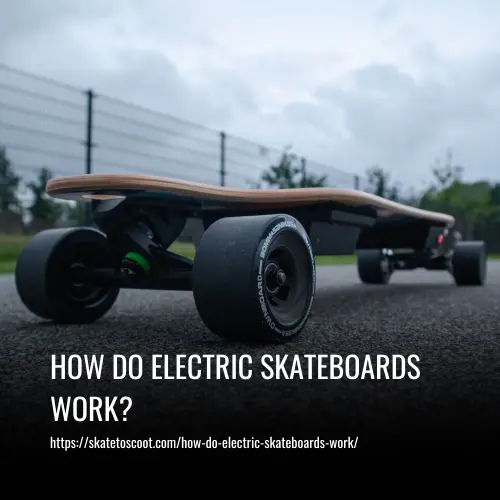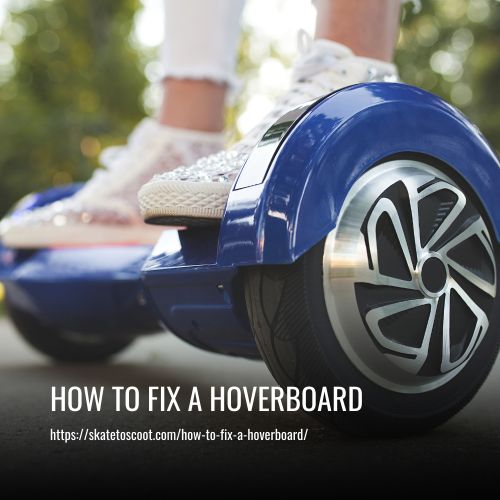As an Amazon Associate we earn from qualifying purchases.
Electric skateboards have become increasingly popular over the last few years. It provides a great means of transportation in and around the city for those who want speed and adventure. But what makes them go? How do electric skateboards work?
In this article, I’ll explain the basics of how an electric skateboard works. We’ll talk about motor types, batteries, ride systems that enhance board performance, and more.

How Do Electric Skateboards Work
Electric skateboards are quite different from regular skateboards in terms of the way they work. The complexity of riding a normal skateboard is not present when it comes to electric skateboarding, and this is due to the changes that have been made in order to make it electronic.
1. How It Moves
Electric skateboards move because of the motor attached to the board. This motor rotates the wheels and gives the rider momentum to keep moving. Instead of having to apply a force yourself, such as pushing off the ground with your foot when riding a normal skateboard, you get easy propulsion from this motor to keep rolling.
The result is that you can enjoy a smooth and easy ride, especially when compared to using an ordinary skateboard. With an electric skateboard, all you need to do is step on and go!
2. Remote Control
Remote controls are at the heart of electric skateboard technology. With a remote control in hand, users can take command of their ride and set it to the speed that best suits their needs. The controller also allows riders to apply brakes for greater control and safety.
All this is done without having to move your feet, but simply by pressing buttons on the remote control itself. Thanks to this technology, electric skateboards don’t need you to push off with your foot in order to start your ride – they’re already activated by a simple press of a button on your remote!
3. Balance
Balancing on an electric skateboard is not much different from balancing on a regular skateboard. You will still need to stand on the board, leaning to help you stay upright. Where it differs is that you don’t need to balance on one leg while pushing off as the momentum is powered by a remote device. As far as turning goes, that’s exactly the same as it would be with a regular board.
One thing to be aware of with electric skateboards is that when you stop and start moving, there can be a slight bump due to the power of the remote, so be sure to be gentle and careful when doing this.
4. Battery
The battery is an essential part of the electric skateboard, providing power to the motor and other electrical components. Without it, the board would simply remain a regular skateboard. The larger the battery size, the higher the cost, but it will also offer a greater range.
Most electric skateboard batteries are constructed using lithium-ion. Lithium polymer and LiPro4 batteries can be found, but they are not as widely available. These lithium batteries need to be handled in a special way for maximum lifespan as well as safety reasons – both are important factors when it comes to owning an electric skateboard!
5. Motor
The motor is the powerhouse of an electric skateboard. It’s what causes the wheels to turn and allows you to ride! This motor converts electrical power into mechanical power, allowing you to move forward with a boost of speed. Electric skateboards use two different types of motors, hub and belt.
Hub motors are small, efficient, and tucked away within the wheels themselves. These tend to be quieter but may overheat due to a lack of airflow, break more easily, and aren’t as powerful compared to belt motors.
On the other hand, belt motors are larger and noisier but they are more dependable and pack more power than hub motors. The motor located underneath the board uses rotating belts to power the wheels when in use.
6. Electronic Speed Controller (ESC)
The Electronic Speed Controller (ESC) is the most important component of an electric skateboard – it’s like a tiny motherboard that acts as the brain of your board. The ESC manages and regulates how much power is pulled from the battery and then distributed to either the motor or brakes of your skateboard.
For maximum efficiency, you want a good electronic speed controller that can manage electricity quickly, feeding it efficiently to the motors or brakes without creating any kind of bottleneck.
A bad one will not be able to do this effectively which could lead to frequent breakdowns. Therefore, getting a quality ESC is key if you want your electric skateboard to run as smoothly as possible.
7. Brakes
When it comes to electric skateboards, the brakes are essential. Without them, there would be no way to slow down or bring the board to a stop. Friction, dynamic and regenerative are the three types of brakes available
Friction braking is the most basic type – it involves applying pressure to the wheel in order to generate heat, which then slows the wheel down. Dynamic braking is similar, but it uses an electrical current to generate heat instead.
The process of regenerative braking utilizes the energy created from braking and stores it in a battery, rather than dissipating it with a resistor.
Electric Skateboard Components
Electric skateboards come with a variety of components to make them run. These components all work together to create a smooth ride for electric skateboard riders.
1. The Mechanical Parts
When it comes to electric skateboards, the mechanical components are key to making sure that the board operates smoothly. The motor converts the electrical energy from the battery into motion for the wheel and pulley, kickstarting the process.
The motor mount connects the motor and wheel to the skateboard truck using welding for secure attachment. This can be angled in such a way that the motor hangs below, allowing for its easy movement.
Then there are a few other pieces of hardware at work here including pulleys and timing belts that transfer power from one component to another. Lastly, we have the timing belt – a looped rubber strip connecting two pulleys by sliding them together – which adds an extra layer of protection while keeping everything tight and properly connected.
2. The Electric Parts
Electric skateboards rely on a few key parts to get them moving and keep them running smoothly. The battery, remote control, Bluetooth transmitter, Bluetooth receiver, and Electronic Speed Controller all work together to give you a unique and enjoyable ride experience.
The battery is the main energy source that powers the motor, supplying electricity to keep it running. The Electronic Speed Controller manages the power intake, making sure that the motor is receiving just the right amount at all times. It’s also connected to the battery, motor, and Bluetooth receiver so that they can communicate effectively.
The Bluetooth transmitter located in the remote control sends a signal to the Bluetooth receiver on your electric skateboard so they can wirelessly ‘talk’ to each other. Finally, with help from your controller, you can choose whether you want to accelerate, brake, or reverse your board as you, please!
3. Other Components
In addition to the basics like wheels, trucks, Decks, and grip tape, which are standard on electric skateboards, there are several components that make this type of skateboarding unique.
For example, a powerful battery provides long-lasting energy for your ride, while wheel guards ensure that your board stays safe even if you take some hard knocks. Tail and nose guards are also featured for extra protection on the deck.
Additionally, both LED nighttime lighting and taillights come standard with most high-end electric skateboards to ensure visibility and safety when traveling at night.
FAQs
Riding an electric skateboard can be safe as long as you use it responsibly. However, like most activities, it still has certain dangers that come with it. Follow the manufacturer’s instructions and wear protective gear like a helmet, knee pads, and elbow pads to stay safe.
When it comes to hills, electric skateboards can generally perform quite well, although some models are better than others. A more powerful motor in your e-skateboard will enhance its ability to handle uphill terrain.
If your electric skateboard battery has a watt-hour rating of 100Wh or less, you are permitted to bring it on an airline flight. This is the current Federal Aviation Administration policy regarding lithium-ion batteries.
Conclusion
In conclusion, electric skateboards are a great way to get around without the hassle of traditional skateboards. Not only are they fast and convenient, but with modern technology and well-engineered designs, they are now even safer than their manual counterparts.
Whether you just want a simple form of transportation or something that’s both fun and functional, an electric skateboard is a perfect solution.
Amazon and the Amazon logo are trademarks of Amazon.com, Inc, or its affiliates.



